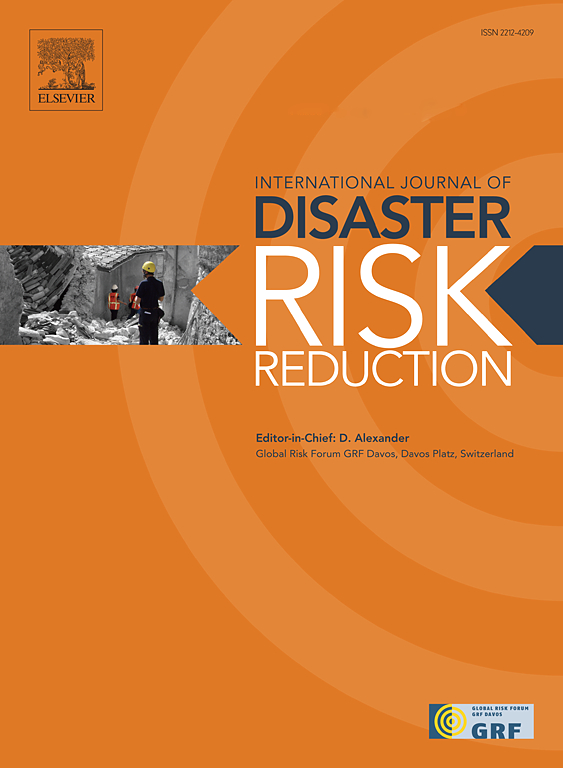Challenges and opportunities in Nepal's early warning communication
IF 4.2
1区 地球科学
Q1 GEOSCIENCES, MULTIDISCIPLINARY
International journal of disaster risk reduction
Pub Date : 2025-02-18
DOI:10.1016/j.ijdrr.2025.105318
引用次数: 0
Abstract
Nepal is exposed to various hazards year-round, particularly those related to hydro-meteorological factors, which can lead to disasters. Recently, advancements in communication technology have enhanced the ability to predict these hazards, allowing for timely preventive measures before disasters occur. An effective communication system is essential for any early warning system. This system should include institutional arrangements, technologies, media, and a mechanism to mobilize human resources to relay messages to various audiences, especially communities at risk.
This study utilized a mixed-methods approach, incorporating participatory assessment techniques to gather and analyse data from multiple sources, including literature reviews, key informant interviews, group discussions, and field observations.
The study found that Nepal's current institutional mechanisms for early warning systems related to floods and landslides have significant gaps and ambiguities in the roles and responsibilities of agencies at all three levels of government, as well as among various sectoral agencies. Additionally, the creation and distribution of early warning messages often fail to take into account important factors such as the choice of media, message format, language, and accessibility for particularly vulnerable groups. As a result, these messages frequently do not prompt the necessary actions to save lives and protect assets.
The paper recommends strengthening communication mechanisms at the national, local government, and community levels. Communication should involve a variety of audio, visual, text, and other messaging forms using appropriate media, including radio, television, phone calls, news portals, social media, and face-to-face interactions. This diverse approach will help ensure that everyone receives messages promptly.
尼泊尔全年都面临着各种灾害,尤其是与水文气象因素有关的灾害,这些灾害可能会导致灾难的发生。最近,通信技术的进步提高了预测这些灾害的能力,从而可以在灾害发生之前及时采取预防措施。有效的通信系统对任何预警系统都至关重要。该系统应包括制度安排、技术、媒体和调动人力资源的机制,以便向不同受众,尤其是处于风险中的社区传递信息。本研究采用了混合方法,结合参与式评估技术,从文献综述、关键信息提供者访谈、小组讨论和实地观察等多种来源收集和分析数据。研究发现,尼泊尔与洪水和山体滑坡有关的预警系统的现行体制机制在三级政府机构以及各部门机构的作用和职责方面存在重大差距和模糊不清之处。此外,预警信息的制作和发布往往没有考虑到媒体选择、信息格式、语言以及弱势群体的可及性等重要因素。因此,这些信息往往不能促使人们采取必要的行动来挽救生命和保护财产。本文建议加强国家、地方政府和社区层面的沟通机制。文件建议在国家、地方政府和社区层面加强沟通机制。沟通应采用广播、电视、电话、新闻门户网站、社交媒体和面对面交流等适当的媒体,包括音频、视频、文本和其他信息形式。这种多样化的方式将有助于确保每个人都能及时收到信息。
本文章由计算机程序翻译,如有差异,请以英文原文为准。
求助全文
约1分钟内获得全文
求助全文
来源期刊

International journal of disaster risk reduction
GEOSCIENCES, MULTIDISCIPLINARYMETEOROLOGY-METEOROLOGY & ATMOSPHERIC SCIENCES
CiteScore
8.70
自引率
18.00%
发文量
688
审稿时长
79 days
期刊介绍:
The International Journal of Disaster Risk Reduction (IJDRR) is the journal for researchers, policymakers and practitioners across diverse disciplines: earth sciences and their implications; environmental sciences; engineering; urban studies; geography; and the social sciences. IJDRR publishes fundamental and applied research, critical reviews, policy papers and case studies with a particular focus on multi-disciplinary research that aims to reduce the impact of natural, technological, social and intentional disasters. IJDRR stimulates exchange of ideas and knowledge transfer on disaster research, mitigation, adaptation, prevention and risk reduction at all geographical scales: local, national and international.
Key topics:-
-multifaceted disaster and cascading disasters
-the development of disaster risk reduction strategies and techniques
-discussion and development of effective warning and educational systems for risk management at all levels
-disasters associated with climate change
-vulnerability analysis and vulnerability trends
-emerging risks
-resilience against disasters.
The journal particularly encourages papers that approach risk from a multi-disciplinary perspective.
 求助内容:
求助内容: 应助结果提醒方式:
应助结果提醒方式:


